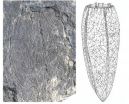(Press-News.org) Sponges are usually considered to be the oldest living animals, having evolved before all other groups. The simplicity of their body structure and tissue organization has for many years made them candidates for the ancestral group of animals, and they have long been regarded as our best illustration of what the earliest animals would have looked like. This has been supported by genetic analyses, which suggest that sponges branched from other animals a very long time ago, deep in the Precambrian. Until recently, most zoologists believed that sponges were little more advanced than a colonial protist, with tissues and organs never fully developed. However, in recent years there has been an increasing appreciation of the complexity of their genetics and biochemistry, and this has cast doubt on the impression of simplicity. Now, new evidence from the fossil record confirms that early sponges were in some ways more complex than their living descendents.
The fossil record of early sponges is patchy. Although they have a mineral skeleton made of minute silica (opal) and/or calcite spicules, in most sponges this is a very delicate structure that is normally destroyed before being fossilized. However, there are occasional sites with exceptionally-preserved fossils around the world, and these often include sponges. Most of these resemble the living deep-sea group called hexactinellids, but this is now known to be a superficial similarity, and the fossils include a range of very primitive sponge groups that evolved before the appearance of the living classes. These 'stem-group' fossils are vital in revealing what early sponges were like, and how they differed from living species.
Most of the early sponge fossils show definite shapes. Usually these are globose or vase-shaped, with a single circular opening at the top. The irregular compound growth form of most living species evolved later, and is not a primitive feature. Some early sponges have an angular outline, usually eight-sided. This is well known among palaeontologists, but has not previously been regarded as significant because the examples are scattered, and any similarity has been presumed to be coincidental. Also, it has been assumed that these prismatic outlines do not represent true symmetry, but are merely shapes evolved in response to their environments.
Remarkable new sponge fossils from the early Cambrian (around 520 million years old) Hetang Biota of Anhui, South China, have now been found by Dr. Joseph BOTTING and colleagues from the Nanjing Institute of Palaeontology, China, and show that there is more to these outlines than has been thought. These fossils, which are classified in the genus Metaxyspongia, had a roughly circular outline but a symmetrical skeleton with four columns of large spicules running up the full height of the sponge. Several similar sponges have also been recovered in the assemblage, and this group is also related to Takkakawia from Canada's famous Burgess Shale deposit. In Takkakawia, the four columns each divide very low down to give eight-fold symmetry, but in the Chinese fossils, there are only four columns throughout.
Isolated sponges with tetraradial symmetry might be fortuitous or environmentally controlled, but there are now examples known from several different groups of early sponges, and no consistent examples of any other symmetry. The consistency of the structural symmetry within Metaxyspongia and its relatives implies that this is a real, genetically-controlled aspect of their biology. The early growth stages of other fossil sponges also reveal the same symmetry, where there is no obvious symmetry in the adults. There is even a trace of this symmetry known in living calcareous sponges, in which the larvae at one stage show a tetraradial arrangement of cells. This range of examples suggest that it is a deep-rooted aspect of sponge biology.
Symmetry is not visible in living sponges, but this may be because they have evolved to be more irregular, with compound, often encrusting growth that is adapted to fit the environments in which they live. Even if their bodies are organized on a tetraradial blueprint, they no longer have the structured organization that allows us to see it, and the genetics dictating their symmetry may even have been degraded or lost. In the early fossils, though, this symmetry was widespread and obvious.
If sponges originally had tetraradial symmetry, then it they were too highly organized to have evolved directly from colonial protists. The symmetry also suggests a direct relationship with one of the other early animal groups, the cnidarians (which include corals and jellyfish). These are the only other animal group to include tetraradial body-plans, and the possibility that there is some shared symmetry between sponges and cnidarians must be considered. Most importantly, this unexpected complexity of early sponges means that we no longer have a good idea of what the last common ancestor of animals looked like – but it seems it may not have looked anything like a sponge.
INFORMATION:
See the article:
Botting, J P, Yuan X and Lin J P. Tetraradial symmetry in early poriferans. CHIN SCI BULL, 2014 vol 59(7): 639-644.
http://csb.scichina.com:8080/kxtbe/EN/abstract/abstract508695.shtml
Science China Press Co., Ltd. (SCP) is a scientific journal publishing company of the Chinese Academy of Sciences (CAS). For 60 years, SCP takes its mission to present to the world the best achievements by Chinese scientists on various fields of natural sciences researches.
http://www.scichina.com/
Widespread tetraradial symmetry among early fossil sponges
2014-04-29
ELSE PRESS RELEASES FROM THIS DATE:
Dampening of positive feelings found to predict postpartum depressive symptoms
2014-04-29
A new KU Leuven study shows for the first time that the dampening or suppression of positive emotions plays an important role in the development of postpartum depression. This has implications for the treatment of depressed mothers.
We often forget that depression is characterised by both negative feelings and a lack of positive feelings. Researchers suspect that this may have to do with the way depression-prone individuals deal with positive or happy feelings. These individuals downplay or suppress positive feelings through a cognitive response style called dampening. ...
New research shows increasing ocean temperatures affecting coral reefs
2014-04-29
FORT LAUDERDALE-DAVIE, Fla. – It seems that coral reefs are experiencing something their human counterparts have been for years – a shrinking "empty nest" syndrome.
That's right – researchers have found that increasing ocean temperatures due to climate change will soon see reefs retaining and nurturing more of their own coral larvae, leaving large reef systems less interconnected.
The study brought together an international group of researchers from NSU's Oceanographic Center; the Australian Research Council Centre of Excellence for Coral Reef Studies and the School ...
Stress research in therapy dogs reveals animals' needs
2014-04-29
So-called animal-assisted therapy is being used increasingly often to treat physical and mental diseases in man. "For stressed persons, animals may serve as "social ice-breakers" and thus motivate them to enroll in therapy in the first place," says Lisa Maria Glenk, the lead author of the study. Scientific investigations on animal-assisted therapy do exist, but these have been largely confined to studying the effects of such therapy on man.
Lisa Maria Glenk conducts research at the Department of Comparative Medicine at Messerli Research Institute. She is a pioneer in ...
Drug monitoring information improves regimen adherence, Carnegie Mellon researchers say
2014-04-29
PITTSBURGH—Most people want to take mediations as prescribed, even if they sometimes need a little help remembering. For them, an automated system that monitors drug taking and provides feedback after the fact may be more useful than one that nags people when it is time to take a pill, researchers at Carnegie Mellon University say.
In a 10-month study of such a system in the homes of older adults with chronic health problems, the researchers found that adherence to a medication regimen improved when people had ready access to a digital display of their medication-taking ...
'Race, risk and behaviors: A type 2 diabetes update'
2014-04-29
Philadelphia, April 29, 2014 – Clinical Therapeutics features a special report in its April issue focusing primarily on the behavioral issues associated with patients' self-management of type 2 diabetes. "Diabetes, perhaps more so than any other chronic disease, requires people to significantly modify their behaviors—sometimes in ways that are contrary to their cultural norms and backgrounds—even when they don't 'feel' sick or experience symptoms of the disease," said John G. Ryan, Dr.PH., Topic Editor for Endocrinology and Diabetes, and guest editor for the April 2014 ...
Facial transplantation: Almost a decade out, surgeons prepare for burgeoning demand
2014-04-29
Plastic and reconstructive surgeons leading the first retrospective study of all known facial transplants worldwide conclude that the procedure is relatively safe, increasingly feasible, and a clear life-changer that can and should be offered to far more carefully selected patients.
Reporting in The Lancet online April 27, NYU Langone plastic and reconstructive surgeon and senior author Eduardo Rodriguez, MD, DDS, says results after nearly a decade of experience with what he calls the "Mount Everest" of medical-surgical treatments are "highly encouraging."
The review ...
Stroke risk reduced if brain blood vessel disorder is left alone
2014-04-29
Treating patients who suffer from a common condition that affects blood vessels in the brain increases their risk of stroke, a study has found.
People with a condition known as arteriovenous malformation (AVM) – which causes blood vessels in the brain to tangle – have a better outcome if doctors treat their symptoms only and not the AVM.
A team of doctors looked at the long-term outcome of patients with the condition, which is caused by abnormal connections between the arteries and veins in the brain.
They found that, over a 12 year period, patients who chose not ...
In a commanding position -- and now cheaper
2014-04-29
It is a requirement of the touchscreens for all our everyday gadgets that they are transparent and at the same time electrically conductive. Solar cells are also unable to operate without such a film, which allows sunlight to pass through it, but can also conduct the current generated. Conventional "transparent conductive oxide" (TCO) films consist of a mixture of indium and tin oxide. Indium in very much in demand in the electronics industry, but is rare, and therefore expensive.
A cheaper option (at least in terms of the materials used) employs zinc oxide mixed with ...
Study highlights importance of parents talking to kids about money
2014-04-29
A new study from North Carolina State University and the University of Texas finds that children pay close attention to issues related to money, and that parents should make an effort to talk with their children to ensure that kids don't develop misconceptions about finance.
"We wanted to know what kids are learning, or not learning, about money from their parents," says Dr. Lynsey Romo, an assistant professor of communication at NC State and lead author of a paper on the research. "This is one of the first studies to look at what young school-age children know about ...
Man landing on Madeira could be 4 centuries prior to its colonization by the Portuguese
2014-04-29
VIDEO:
Four centuries before its colonization by the Portuguese, man may have landed on Madeira Island. This can be deduced from a study led by the Spanish National Research Council (CSIC),...
Click here for more information.
According to the results, published in the Proceedings of the Royal Society B journal, house mice may have landed on the island before 1036, most likely transported by a ship. The article suggests that the introduction of this species would result in an ...




